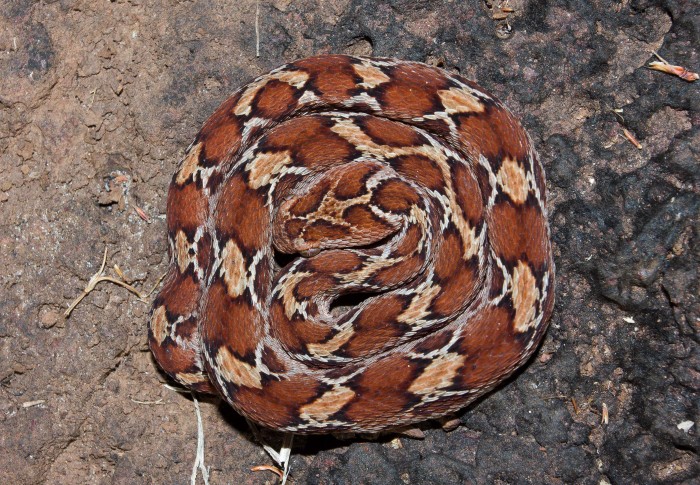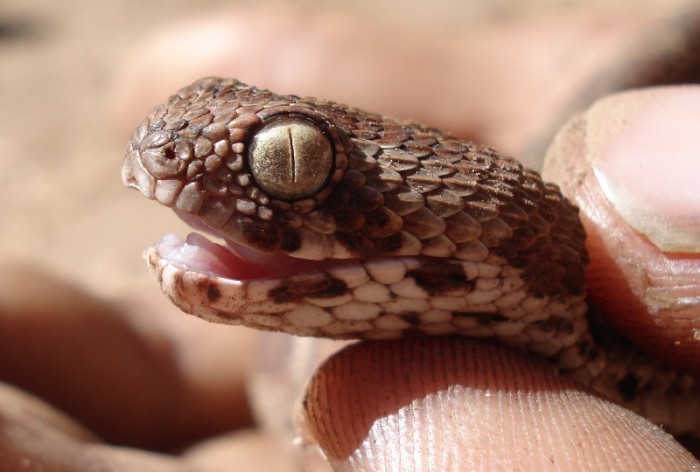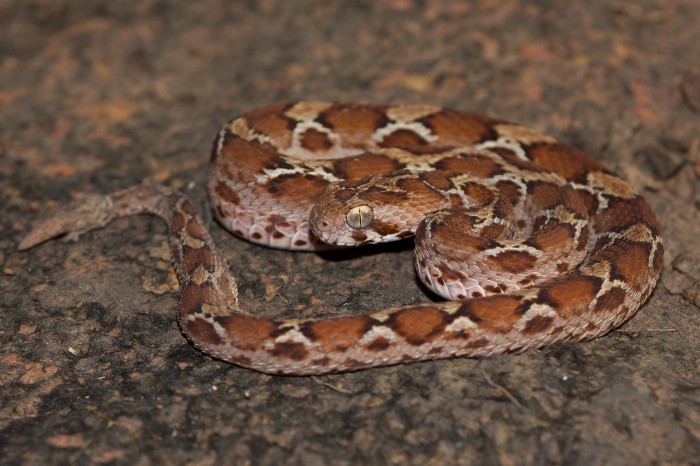Click on the pics themselves to see them in high resolution.
In my last column we got introduced to the first of the ‘Big Four’ venomous snakes: the Russell’s Viper. This time let’s get to know its close but much more diminutive relative, the Saw-scaled viper.
Saw-scaled vipers are relatively uncommon in Goa where I live and in my twelve years of snake rescuing I’ve probably caught only three or four. To get photographs of the one you’re seeing on this page I had to actually borrow one from a fellow snake handler.
I remember searching for Saw-scaled vipers with Rom Whitaker many years ago on the Porvorim plateau in North Goa. Saw-scaled vipers prefer dry rocky landscapes and, according to Rom, the plateau seemed a good place to find some of them.
It must have been about 7.30 in the morning and the sun’s rays were just warming up the cool surface of the plateau; a perfect time to find these little vipers since most of them would be basking and warming up for the day.
We carried sticks and used them to turn aside every stone that seemed promising enough to harbour one of these small creatures.
Forty-five minutes past our starting time we still hadn’t found anything.
‘It’s odd not to have found a single one so far,’ said Rom finally, chucking his stick aside with an amused look on his face. ‘In a place like Ratnagiri, we’d have found a dozen by now.’
It could be that Goa’s humid environment has something to do with the rarity of the Saw-scaled viper. Or it could also mean that Saw-scaled vipers are much more common than we believe them to be, only no one’s looked hard enough for them. This little viper is after all quite difficult to locate: picture searching for a ten-inch odd, drab brown snake, excellently camouflaged on brown ground, and you’ll know just what I’m talking about!
Saw-scaled vipers are named after the sawing sound they make by rubbing their rough body scales against each other when disturbed. To do this, a viper squeezes itself into a squashed S-shaped pattern, moving its coils in opposite directions to create a truly hypnotic visual. The head sits in the front groove of the coils, ready to strike if necessary. If, however, the viper decides to make a getaway, it can move quickly, and does so in the characteristic ‘sidewinding’ fashion of desert vipers.
These reptiles are among the most hot-tempered snakes on the planet and are quick to bite if provoked. They have good reason to be so aggressive; being small, they are in constant danger of being turned into a meal by hungry predators. Their aggressive nature must make predators think at least thrice before picking on the members of this belligerent little species.
Saw-scaled vipers themselves are no less formidable predators, adding venomous centipedes and even scorpions – along with geckos, mice, frogs and skinks – to their food menu.
They are so small that many of their distinctive features go unnoticed. For example, it was only until I’d photographed one of them with a macro lens that I discovered that they have large eyes with a beautiful golden iris and a vertical black pupil.
The one in the photograph has its iris constricted to a slit as a reaction to the strong sunlight in which it is being held (you must have noticed a similar thing happen to your pet cat’s eyes when they face strong sunlight)
Finally, one of the identifying characteristics of a Saw-scaled viper is the distinctive spear-shaped mark at the top of its head. It also shares the trademark features of vipers with others from the same viper family: an excruciatingly painful bite, long moveable front fangs, and ovo-viviparity.




